» Next Entries
The Archives
-
No Compromise, Periodicals
No Compromise #23-26
02.17.13 | PermalinkNo Compromise 23-26 (2004, Santa Cruz / San Francisco, CA)
One of the lessons that archiving old animal liberation publications has taught me is that the most extreme actions have rarely produced much in the way of results for animals. A public that already sees veganism as odd might still see the value of rescuing animals from a laboratory, but will never support a car bombing. When innocents are injured, or when murder was the goal, the backlash starts to creep into our own ranks, and as we fracture law enforcement and industry groups take advantage. In the end, I can think of no bombing (or contamination, or grave robbing, etc.) which advanced the cause of animal rights more than it harmed it. This is not to say that bombings and the like could never be successful. At later stages of many revolutionary struggles, when the majority of the public supports the cause, bombs can clear away in one night what years of protest could not. While a movement is in its infancy, however, it could be argued that more often than not bombs blow up in our faces.
And so it was in 2004 when a group calling itself the Revolutionary Cells Animal Liberation Brigade carried out two bombings of HLS related targets in California. The movement was left to make lemonade from truly shitty lemons, and No Compromise did their best to mitigate the harm of the actions while keeping activists focused on the real enemy.
The year continued with the indictment of the SHAC 7, the emergence of Austria as a leader in the movement, and some exciting open rescues. Sarahjane Blum and Ryan Shapiro’s organization, GourmetCruelty.com, carried out one such operation that piqued public interest and eventually resulted in a sympathetic program on Animal Planet. Elsewhere Gina Lynn was imprisoned for defying the Seattle grand jury, Billy Cottrell was arrested for a massive SUV dealership arson, and the Universtiy of Iowa was treated to the most sophisticated lab raid to occur since the early 90s.
Every time we post a year of No Compromise we say the same thing: that this is essential reading for those who wish to understand the recent history of our movement. This posting is no exception. No Compromise was the best AR publication of its era, and 2004 saw the publication refining its strengths and providing their readers with four of the best issues yet.
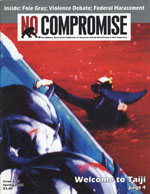



-
Books
The raw stuff of history: An incomplete, unfinished Ronnie Lee manuscript.
01.31.13 | PermalinkUnfinished Manuscript (Early to mid 1980s, England)
A few months ago we contacted our friend Robin Webb to borrow some of his animal liberation publications for scanning. Robin cheerily agreed to send us a package, and when it arrived it included some of the rarest publications we have yet received. We gingerly pulled one gem after another from the box, and just when we thought we couldn’t be more excited we found this unfinished history of the ALF written by Ronnie Lee.
Drafted almost thirty years ago, this publication spent decades in police custody before ending up in the possession of the ALF Press Office. After its trip through the evidence room the manuscript is missing over a hundred pages, but still bristles with history.
We are still investigating the story behind this document, but felt it would be unfair to our readers to keep it out of circulation any longer. Here, distributed to the public for the first time, is the story of the Animal Liberation Front as told by one its founders.
…
-
One-off publications
Into The 90s With The ALF / This Is The ALF #2
12.26.12 | PermalinkInto The 90s With The ALF (1991, City Unknown, England)
This Is The ALF #2 (1994, City Unknown, New Zealand)First things first: the posting of these two old ALF publications requires a little uncomfortable honesty. You see, neither zine is particularly well written, the advice given on tactics (and strategy) isn’t particularly insightful, and everything covered inside has been dealt with better elsewhere. However, these were both widely distributed in their time, and as we aim to be a complete archive both of these anonymously distributed tracts deserve a place here on the site.
With that said (or written, as it happens to be!) these zines provide us with a view into the issues and campaigns being discussed by radical animal liberationists during the early 90s. The focus on economic damage versus rescue is particularly interesting, and some might argue resulted in a public relations failure for the movement. Also intriguing is tracking the way the contents traveled around the world to be republished in different countries. Into the 90s carries material originally published in Canada, This Is the ALF has content from the United States and England. The loose network of animal liberation militants that existed prior to the popular use of the internet is fascinating, and imagining how the anonymous authors of these publications received the items they ultimately reprinted is entertaining fodder for the imagination.
All told, these primers were meant to provide newcomers with a quick overview of the Animal Liberation Front, and to spread the use of direct action in their respective countries. They do so, just not in a particularly inspiring manner.
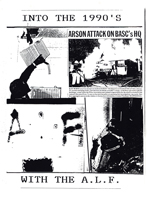

-
Arkangel, Periodicals
Arkangel 8-9
12.10.12 | PermalinkArkangel #8-9 (1992. London, England.)
After serious problems with police raids and repression, Arkangel managed to produce two issues in 1992. The focus of the magazine was still the networking of local grassroots organizations and opinion pieces by members of the movement, but some wonderful morsels of history pop up between these covers. Beyond the charm of finding out where the graphics that we’ve been reprinting forever come from, you will also learn about the early days of the McLibel case, how the British government prepared for Ronnie Lee’s release from prison, and many other interesting tidbits.
What was of greatest interest to me, however, was a short article in issue #9 written by Sue Smith. Sue is an unsung hero of the animal liberation movement, one of the founders of the Band of Mercy, and an original ALF activist. She was never caught for illegal activity, and it was only after her death that her participation in direct action became known. There is little written about her, but her brief article gives us a tiny sense of her level of compassion and concern. If any of our readers have more information about Ms. Smith, please contact us.

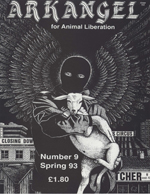
-
Books, Most Popular
The Mothercage
07.13.12 | PermalinkThe Mothercage (2004, Wolverhampton, England)
“Those who carry out direct action in the cause of animal liberation are,
indeed, doing something extraordinary, but they are not super-beings, just
ordinary people who care sufficiently to risk their own liberty in bringing
freedom to other creatures. But ordinary people have their differences,
their frailties, their loves and hates and their fears…”
Ronnie Lee, from the introduction.Maire ni Bhradaig’s The Mothercage is a fictional portrayal of an Animal Liberation Front raid. Originally published in England, it was never widely available outside of Europe. Although it is written for young adults, the characters are complex enough to hold the interest of older readers. The author’s knowledge of militant AR culture makes the story a realistic representation of how activists might interact, and unlike Rage and Reason and Animal Rites, there are no former green berets running around with machine guns.
The strength of this book is Bhradaig’s willingness to present the people behind the mask as plainly, painfully human. Outside of Paul Chadwick’s Concrete: Think Like A Mountain you will not find a more accurate portrayal of a group of radicals. While some of the book’s cast are wonderful people, others are bigots, adventurists, or cowards hiding their flaws behind a balaclava.
The grassroots animal and wilderness liberation movements indulge in far too much hero worship, a tendency that has led us to embrace some very shady characters over the years- characters who often harm our credibility in the long term. The Mothercage serves as a reminder that the masked figures we so admire are not always so admirable, and more importantly, that improving ourselves increases our effectiveness as activists.
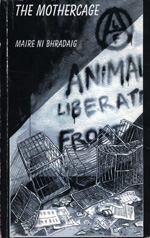
…
-
Books, Most Popular
Against All Odds
06.05.12 | PermalinkAgainst All Odds (1986, London, England.)
Editors note: The TALON Conspiracy endeavors to archive the best, most complete copies available of all publications in our collection. Although Against All Odds had previously been posted on March 14, 2011, we have since found a higher quality copy from the original publisher. Our first posting had been a Canadian reprint with bad generation loss that was also missing several photos printed in the British edition. The Canadian version can still be found here.
Originally published in England as a book 25 years ago, Against All Odds was regularly distributed in North America as a low cost zine. It remains one of the best publications documenting the rise of the Animal Liberation Front and the Animal Liberation Leagues in England.
In many ways, the 1980s was the high water mark of the Animal Liberation movement. In 1984, thousands of people in England participated in direct action against vivisection, staging large scale raids against six labs. Multitudes of people would overwhelm security in broad daylight and remove the oppressed creatures inside, often causing minor damage along the way and taking out valuable footage which was used to grow the movement. Many dozens of arrests followed these raids, but it is arguable that police response was not the cause of death of this mass militant movement taking shape in the UK.
Around this same time we saw the emergence of groups such as the Hunt Retribution Squad and Animal Rights Militia. Rather than rejecting the idea that animal rights activists were fanatics, HRS and ARM embraced that term and seemingly reveled in the negative imagery presented by the media. The Hunt Retribution Squad went so far as to release images of masked activists wielding clubs, chainsaws, and even pavement cutters. The front pages of newspapers widely reported on threats made by HRS to harm hunters if they attacked human opponents of hunting. In the end these counter-assaults never took place, but the damage was done. This type of macho posturing was repellant to many in the movement, and it provided great fodder for the police, courts, and conservative PR teams to use in the war against direct action. Certainly, the few acts of violence taken by the Animal Rights Militia could not outweigh the value of the mass raids and rising public consciousness taking place in England at the time and largely contributed to the recession of a growing struggle for non-human emancipation.
Written in accessible language and unafraid of nuance, its tactical analysis and historical documentation remain valuable to this day. Against All Odds is essential reading for the modern animal liberationist.

-
No Compromise, Periodicals
No Compromise #12-14
05.15.12 | PermalinkNo Compromise #12-14 (1999, Old Bridge, NJ and Santa Cruz, CA)
If I had to create a list of my favorite years in animal and earth liberation history, 1999 would be in the top 5. As the movement looked towards the new millennium there seemed to be an intense urgency in the air, perhaps people felt the need to close the 20th century with a bang or leave their mark before the world ended in a technological melt down on Y2K! Whatever the reasons, direct action reached a fever pitch. Lab raids returned to the United States, the Earth Liberation Front continued it’s ascendancy, Hillgrove farm was shut forever, and everyone seemed to be preparing for the World Trade Organization ministerial in Seattle. Across the globe there was a sense that people were not going to take it anymore, and whether you were struggling against bio-technology or prisons or speciesism, chances are good that you were employing some form of illegal tactic.
No Compromise may not have covered everything going on in the global struggle, but if it was animal lib related then chances are it was covered in these three issues. From the death of Alex Slack to end of the annual Hegins pigeon massacre, you’d be hard pressed to find a more complete overview of these twelve action packed months.
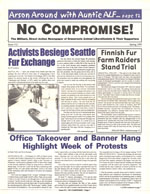
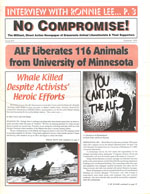
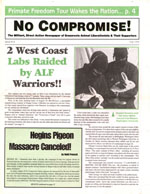
-
Periodicals
When the Nationals Were Radical, Part 1
03.08.12 | PermalinkPeTA News, Various issues (1985-1990. Washington, D.C.)
“Why Property Damage? ALF action goes beyond acts of protest. Animals will always be rescued where possible, but the main purpose of the action is often economic sabotage. Property and “things” hold no sacred value-the opposite, in fact, if they are used to cause pain and death. To STOP the very real violence of torture and killing, inanimate objects must be rendered unusable. When equipment is broken, work cannot go on as usual with a new batch of victims, insurance rates go up and so do security costs, making the enterprise less profitable.” PeTA News, Volume 2 #1
“When questioned on Irish television about an action against a butcher shop, Morrissey, an avid vegetarian, was asked “What about the safety of the butchers?” Responded Morrissey, “When you think of the horror experienced by millions of animals in slaughterhouses each year, what’s a few butchers?” His song Meat Is Murder topped the charts in 1985.” PeTA News Volume 3 #1
Imagine for a moment that a young animal rights activist with very little knowledge of the movement’s history finds a time machine and heads back into the early 1980s. Upon arrival they decide to get involved with a militant group and begin asking who they should join. At every turn they are told that PETA is the most militant group in the United States. This seems absurd to our young activist! “All PETA does is embarrass the movement with offensive ad campaigns and nudity! They are celebrity driven and devoid of substance, they kill healthy feral cats and don’t even have a rights based philosophy! They even demoted an employee for publicly supporting politically motivated arson!” Angered, our imaginary friend stomps into the DC area offices of the group to re-write history, and is shocked with what they find…
People for the Ethical Treatment of Animals experienced a meteoric rise in membership and notoriety in the early 1980’s as a direct result of their support for (and participation in) illegal direct action. Their relationship with the Animal Liberation Front was symbiotic: PETA provided the ALF with whistlebower information, credible spokespeople, and sympathetic coverage of raids. In return, PETA was placed in the media spotlight and received undercover footage and documents from the ALF that were often parlayed into high profile (and lucrative) campaigns. The atmosphere of popular militancy was exciting, and after years of slow progress people felt that supporting PETA meant backing a faster, more direct path to rights for non-humans.
PETA sold ALF support merchandise in their newsletters, ran a legal defense fund for people accused of unlawful activism, and helped popularize the concept of mischief in defense of animals. For example, PETA News sold squirt bottles of red permanent fabric ink alongside the warning that since the damage done to furs would be permanent, you should only spray the ink on your own furs! Articles talked about a likely apocryphal 15 year old who got grounded for passing out “Throw a Brick Through McDonald’s Day” pamphlets, and later chuckled as he got caught with paint bombs under his bed. Incidentally, the same article described how young “Kevin” made the paint bombs. These examples only just barely scratch the surface of the early militancy of Alex Pacheco and Ingrid Newkirk’s fledgling organization.
The story of animal rights in the United States can not be told without a thorough examination of the early days of PETA, an era sure to shock newcomers. In the coming months we will begin a more in depth analysis of their early days, but in the meantime jump into the TALON time machine and prepare to have your mind blown by these early issues of PeTA News.

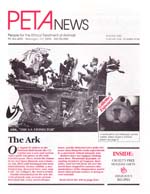







-
Arkangel, Periodicals
Arkangel #4,5,7
01.02.12 | PermalinkArkangel #4,5,7 (1990-1991. London, England)
Our posting of the complete Arkangel continues into the 90s with issues 4, 5, and 7. The omission of issue 6 is not an oversight- it was never printed. Arkangel was founded by Ronnie Lee, who was serving a 10 year sentence during the magazines early years, and edited by Vivien Smith, who found herself in a jail cell by the time issue #6 was scheduled for release. Sensing the possibility of shutting down this crucial publication, law enforcement in England ransacked the Arkangel office just before the layout of issue #6. It was lost to the ages, and with Vivien facing serious charges a new team of interim editors anonymously produced Arkangel #7, causing a slight decline in the publication’s overall quality.
The history covered by these three issues is tremendous. The death of Mike Hill, Animal Aid’s disastrous labeling of direct action as “terrorism,” and the return of the ALF Press Office are all reported upon, along with updates from groups around the world. Amidst the columns reporting on the actual work of activists though is a disturbing amount of debate, much of it centered on whether animal rights groups should allow participation by racists, nationalists, and separatists. The back and forth articles from one issue to the next mostly fail to recognize the most offensive nature of the argument – that there should even be an argument! It boggles the mind that anyone could see a benefit to taking on the baggage of these far right lunatics and their disgusting politics. During a decade where skinhead violence claimed the lives and dignity of so many it is particularly disheartening that some in our movement saw fit to offer these thugs a place at our table.

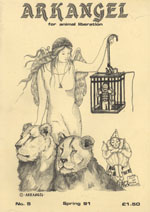

-
Periodicals
The Animal Liberation Front Supporters Group Newsletter #17
07.17.11 | PermalinkThe Animal Liberation Front Supporters Group Newsletter #17 (1985, London, England.)
(Editors note: The complete set of SG newsletters is now available HERE.)
It is not usually our habit to put up a single issue of a serialized publication as we prefer to post an entire year, or run of magazines, in a single post. However, we must make an exception for the ALF SG Newsletter #17, which contains a fantastic investigation of the Band of Mercy and comes complete with an image of their first press statement from November of 1973. The significance of that image, the very first communique from an underground group fighting on behalf of other species, can not be understated.
When one considers how entrenched animal exploitation is in our culture, the idea that a tiny band of revolutionaries could push back against that social tide by burning down an animal laboratory under construction is a watershed moment. The arson attacks and raids carried out by the Band of Mercy were pivotal in the creation of the animal rights movement.
This issue has much more in store for readers. The second communique from the Animal Rights Militia is presented in it’s entirety, and although it provides a myopic examination of the role of liberatory violence it is none the less a fascinating read for lovers of animal rights history. The story of the famous Ecclesfield Beagle raid is presented by one of it’s participants, Roger Yates has a long letter explaining his feelings on the uselessness of national groups, and funny pseudonyms abound! If you thought Earth First!ers had funny names, wait till you get a load of Captain Kirk, Martial Rose, and Black Vixen!
If you look carefully you may notice that this issue is missing some pages. We do not know if this is because they were removed by their original owner, or if this is one of the issues of the SG rumored to have been “edited” by the British government as it left post offices on it’s way to subscribers.

…
» Next Entries





